Everything you need to know about USB-C & Thunderbolt 3 on Apple's new MacBook Pro
Apple has decisively transitioned its new MacBook Pros to use the slim, unidirectional new USB-C port first introduced on the Retina MacBook a year and a half ago. Its latest MacBook Pro machines not only supply more connectors, but also support the enhanced new USB 3.1 Gen 2 and Thunderbolt 3 protocols for blazing fast wired connectivity and high resolution displays.
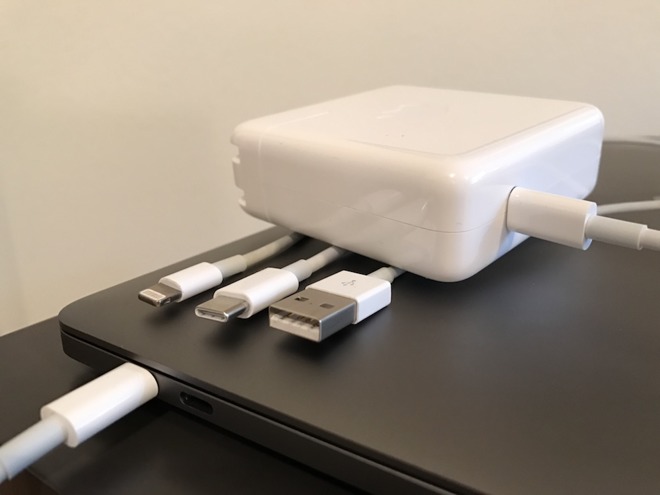
Lightning, USB-C and the original USB-A
While many are weeping over the death of their beloved MagSafe, I've always been of the opinion that the connector was simply a proprietary effort by Apple to monopolize the resale market for charging adapters.
The one-piece design of MagSafe adapters also meant that MacBook power adapters could only be used to charge a MagSafe notebook; the cable was also integrated into the adapter, so if the wire itself or its connector junction wears out or is damaged you have to replace both as a package.
Another advantage of USB-C for charging over MagSafe is that you can supply power from either side of the machine, and also draw power from a connected display, dock, external battery, solar panels like the Solartab C or any other device that supports the USB-C Power Delivery specification.
With power delivery over the same USB-C cable as Thunderbolt 3, you can now connect a display with just one cable. Apple's previous Thunderbolt Display required both a Thunderbolt 2 cable and a MagSafe power connection. Before that, Cinema Displays needed three cables: one for video, one for power, and one for USB.
The new USB-C power adapter that ships with MacBook Pro models can be used to power the laptop via the included USB-C charge cable, or you can plug in a USB-C to Lightning cable (or use a USB-C to USB-A adapter along with your existing Lightning to USB cable) and use it to charge your iPhone or iPad, as quickly as those devices can support.
The 15 inch MacBook Pro ships with an 87 watt power adapter, while the 13 inch model includes a 61 watt adapter. The same adapter can be used to charge either system, although the smaller version will charge the battery slower.
Apple sells rather expensive replacement MacBook adapters, but given its support for standardized USB-C Power Delivery, you can now shop around for less expensive alternatives. The untethered USB-C charge cable Apple bundles is also sold separately, and there's no ears for wrapping it around the adapter--likely because the cable is both thicker and detachable.
Just as with the power adapters included with iPads, there's also no longer any extended AC cable included, but you can still pull the adapter's integrated power plug out and replace it with one of the long AC cords you likely already have.
When used to charge iOS devices, an iPhone or iPad will only draw the wattage (voltage x amperage) it is designed to use, regardless of the capacity of the adapter to deliver higher power. However, Apple ships both its iPhones and iPads with lower rate adapters than those devices are capable of using.
All iPhones continue to ship with Apple's ridiculous 5 watt plug, despite being capable of charging much faster with the 10 or 12 watt adapters that ship with iPads. Plugged into USB-C on the new MacBook Pro models (or its higher watt power adapter), both iPhones and iPad will charge as fast as they can (but no faster).
The max charge rate for iPhone 7 Plus appears to be 10 watts (5.2V x 2.1A), but the 12.9 inch iPad Pro can make use of the higher rate charging that's part of the newer USB PD (Power Delivery) specification: apparently the same 29 watts (at 14.5V x 2.0A) delivered by the Retina MacBook.
While iOS devices don't need (and can't fully use) as much power as the MacBook Pro USB-C adapters deliver to the laptop they ship with, they fact that they can now be used with these adapters means that you only have to pack one brick when traveling. The USB-C ports on the MacBook Pro models also deliver 10 watts (5.2V x 2.1A, below 2100mA when adding Extra Operating Current to the Required Current) to any directly connected iOS device, so you can charge your iPhone quickly that way as well.
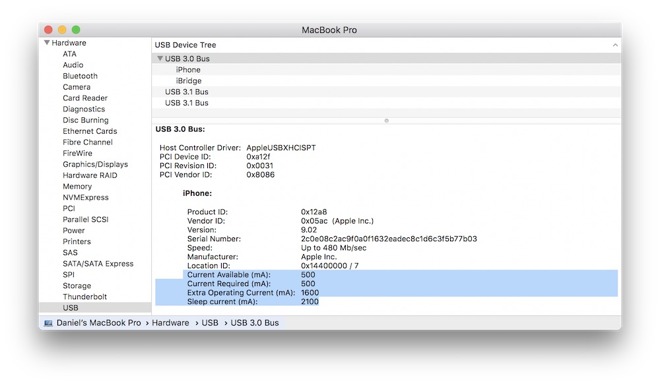
The company's decisive move to USB-C on the Retina MacBook was constrained by the fact that Apple only put one port on the machine, but the new MacBook Pros deliver two (on the low end 13 inch model without a Touch Bar) or a luxurious four on its other MacBook Pro models (more USB ports than any other previous MacBook Pro).
Despite offering twice the USB ports of its previous MacBook Air, the new models are even thinner, thanks in part to the smaller size and volume consumed by the much more compact USB-C port. Like Lightning, the new port also works when plugged in either direction.


It would not be better for the new MacBook Pro to be saddled with old connectors for USB-A and Thunderbolt 2 / Display Port. In fact, the edge walls of the new system are slimmer than the shell of an USB-A port itself (below, pictured with Apple's $9 USB-C to USB-A 3.0 adapter).

The new MacBook Pro edge wall is slimmer than the shell of an USB-A port
Not having to visually line up the direction of a USB port is so much nicer than the original USB type plug, and the fact that a simple adapter might be needed in the transition -- one that costs less than $10, or can be solved with the use of a USB-C hub, really leaves this a problem without an issue.
A 5K display packs over 2.5 times as many pixels as even the built-in Retina Display, but thanks to Thunderbolt 3 this machine can power two of them. It can also drive four 4K screens. You'll need to be careful about selecting cables, as the physically identical USB-C used by USB 3 and Thunderbolt 3 has different requirements for cabling related to the speed and power a given cable can support (just the same as a given Category of Ethernet cabling).
Note in particular that the Apple-supplied power adapter charging cable, despite having USB-C ports on either end, is not actually a USB 3.0. USB 3.1 or Thunderbolt 3 cable.
It can't be used with another USB-C Mac to support Target Disk Mode or to transfer data via Migration Assistant. For that, you'll need a USB-C cable that supports USB 3 or USB 3.1 data.
Apple states that the "USB-C Charge Cable" it supplies in the box can only support USB 2.0 data transfer speeds (up to 480 Mbps) to another USB 2.0 device. The same USB 2.0 speed limit applies to Apple's USB-C to Lightning cable.
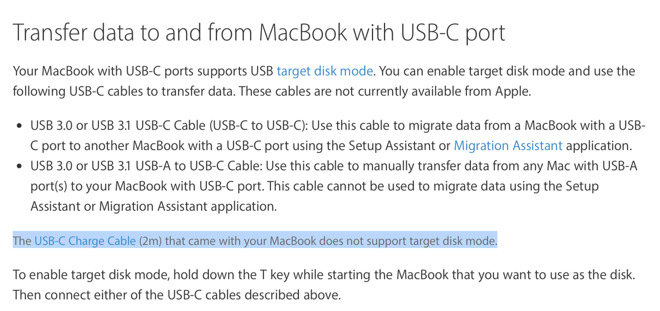
However, Apple's Lightning plug can support USB 3.0 speeds, as it does on the 12.9 inch iPad Pro (supporting the Lightning to USB 3 Camera Adapter). It does not appear that any other iOS devices currently support USB 3 speeds over Lightning, however.
The new MacBook Pro models not only support USB 3.1 (up to 5 Gbps speeds, used by the Retina MacBook) but also the newest USB 3.1 Gen 2, which supports data transfers up to 10 Gbps.
Beyond USB, the super flexible, uniform "everything on one connector" design of USB-C also support's Intel's Thunderbolt 3, which multiplexes PCIe and DisplayPort. Thunderbolt 3 has an upper limit of 20 Gbps per channel on two separate buses, supporting throughput of up to 40 Gbps.
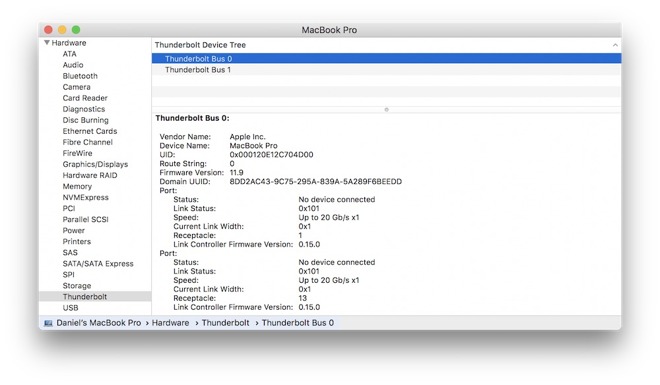
DisplayPort 1.2 drives the graphics capabilities of the AMD Radeon Pro GPU to drive four external display streams beyond the built in screen (Apple said the GPU also draws the Touch Bar, but the system does not enumerate the Touch Bar as a connected display).
An attached 5K display takes up two DisplayPort 1.2 streams (effectively stitching together two displays into one large panel), meaning you can "only" connect two 5k displays. However, Apple's implementation of DisplayPort 1.2 and Thunderbolt 3 means a 5k display can be driven over a single cable, an industry first.
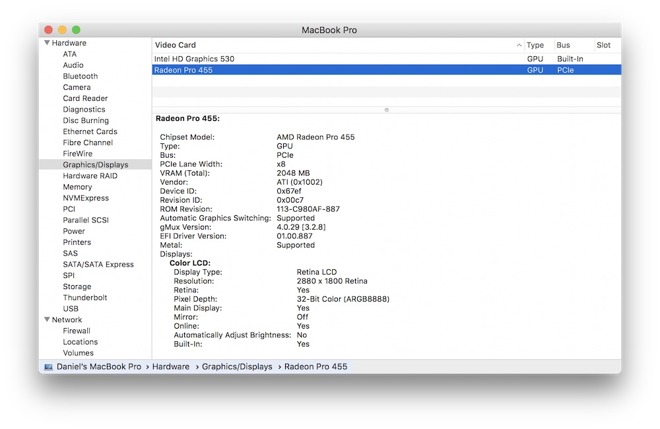
Thunderbolt 3 is clearly the future of cabling high performance peripherals, displays and external storage units. The fact that it uses the same physical connector as USB 3.1 Gen 2 on the new MacBook Pros makes it even more flexible and universal, without adding additional ports and requiring specialized, unique cable types.
However, you'll most certainly need new cable adapters for some of your existing devices, including your iPhone. Several low cost USB docks, some sporting an SD Card reader, should adequately handle most user's backward compatibility needs.
Remember that USB-C cables are not all the same: some (like the "charge cable" Apple bundles) can only support USB 2 (!) while other versions can only support USB 3 but not Thunderbolt 3. Some versions are also limited by their power capacity.
I did not have a Thunderbolt 3 cable or storage system to test. However, the internal SSD uses PCIe, just as Thunderbolt does. It is very fast, scoring 1875.4 MBps (15,000 Mbps) in writes and consistently maxing out the benchmark app at its upper limit of 2,000 MBps (16,000 Mbps or 15 Gbps) for reads. That's really fast.
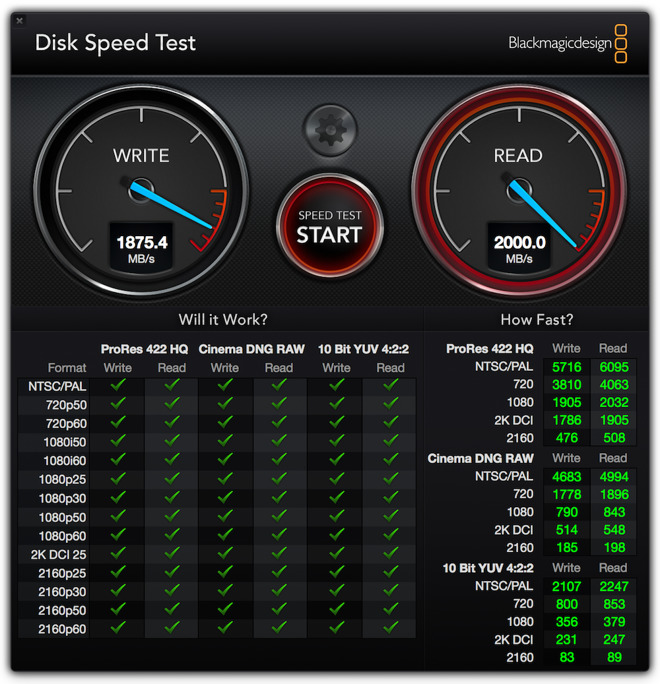
Apple outlines SSD sequential read speeds up to 3.1 GBps and sequential write speeds of 2.2 GBps, which is up to 50 percent faster than the previous generation of MacBook Pros.
While connector size and volume is not as big of an issue on desktop machines, the new versatile, universal and more powerful connectivity afforded by Thunderbolt 3 and the USB-C connector is clearly the future.
USB 3.1 speeds can be delivered over the older, larger USB-A connectors that are currently ubiquitous, but Thunderbolt speeds, and features like DisplayPort support, can't.
For iOS devices, USB-C offers less of an attraction, given that they can't support Thunderbolt 3 connectivity (which requires an Intel processor) and don't need DisplayPort video output to external displays.
The fact that basic USB 3.0 connectivity can be supported on existing Lightning connectors and legacy USB ports suggests that iOS devices might not make the switch as quick, requiring a longer transition period of using adapters. At the same time, there's a lot you can now do wirelessly rather than needing to plug in a cable.
WiFi sync, AirDrop photo and file transfers and iCloud based sharing are all more convenient than plugging in a cable. That leaves power charging as the biggest reason for plugging a cable into an iOS device, and that issue may be solved by induction or truly wireless charging before USB-C becomes completely and universally adopted.

Lightning, USB-C and the original USB-A
Flex your power
Like the Retina MacBook, the new MacBook Pro models no longer use MagSafe, Apple's quick release magnetic plug for delivering power. Power is now delivered via USB-C, which fits snuggly enough to pull your laptop off the edge of a table if something inadvertently tugs the cable hard enough.While many are weeping over the death of their beloved MagSafe, I've always been of the opinion that the connector was simply a proprietary effort by Apple to monopolize the resale market for charging adapters.
The one-piece design of MagSafe adapters also meant that MacBook power adapters could only be used to charge a MagSafe notebook; the cable was also integrated into the adapter, so if the wire itself or its connector junction wears out or is damaged you have to replace both as a package.
Another advantage of USB-C for charging over MagSafe is that you can supply power from either side of the machine, and also draw power from a connected display, dock, external battery, solar panels like the Solartab C or any other device that supports the USB-C Power Delivery specification.
With power delivery over the same USB-C cable as Thunderbolt 3, you can now connect a display with just one cable. Apple's previous Thunderbolt Display required both a Thunderbolt 2 cable and a MagSafe power connection. Before that, Cinema Displays needed three cables: one for video, one for power, and one for USB.
With power delivery over the same USB-C cable as Thunderbolt 3, you can now connect a display with just one cable
The new USB-C power adapter that ships with MacBook Pro models can be used to power the laptop via the included USB-C charge cable, or you can plug in a USB-C to Lightning cable (or use a USB-C to USB-A adapter along with your existing Lightning to USB cable) and use it to charge your iPhone or iPad, as quickly as those devices can support.
The 15 inch MacBook Pro ships with an 87 watt power adapter, while the 13 inch model includes a 61 watt adapter. The same adapter can be used to charge either system, although the smaller version will charge the battery slower.
Apple sells rather expensive replacement MacBook adapters, but given its support for standardized USB-C Power Delivery, you can now shop around for less expensive alternatives. The untethered USB-C charge cable Apple bundles is also sold separately, and there's no ears for wrapping it around the adapter--likely because the cable is both thicker and detachable.
Just as with the power adapters included with iPads, there's also no longer any extended AC cable included, but you can still pull the adapter's integrated power plug out and replace it with one of the long AC cords you likely already have.
When used to charge iOS devices, an iPhone or iPad will only draw the wattage (voltage x amperage) it is designed to use, regardless of the capacity of the adapter to deliver higher power. However, Apple ships both its iPhones and iPads with lower rate adapters than those devices are capable of using.
All iPhones continue to ship with Apple's ridiculous 5 watt plug, despite being capable of charging much faster with the 10 or 12 watt adapters that ship with iPads. Plugged into USB-C on the new MacBook Pro models (or its higher watt power adapter), both iPhones and iPad will charge as fast as they can (but no faster).
The max charge rate for iPhone 7 Plus appears to be 10 watts (5.2V x 2.1A), but the 12.9 inch iPad Pro can make use of the higher rate charging that's part of the newer USB PD (Power Delivery) specification: apparently the same 29 watts (at 14.5V x 2.0A) delivered by the Retina MacBook.
While iOS devices don't need (and can't fully use) as much power as the MacBook Pro USB-C adapters deliver to the laptop they ship with, they fact that they can now be used with these adapters means that you only have to pack one brick when traveling. The USB-C ports on the MacBook Pro models also deliver 10 watts (5.2V x 2.1A, below 2100mA when adding Extra Operating Current to the Required Current) to any directly connected iOS device, so you can charge your iPhone quickly that way as well.

USB-C is smaller and omnidirectional
Did you notice how quickly the "Apple isn't innovating!" crowd changed its tune to "Apple is disrupting the comfortable status quo!"?The company's decisive move to USB-C on the Retina MacBook was constrained by the fact that Apple only put one port on the machine, but the new MacBook Pros deliver two (on the low end 13 inch model without a Touch Bar) or a luxurious four on its other MacBook Pro models (more USB ports than any other previous MacBook Pro).
Despite offering twice the USB ports of its previous MacBook Air, the new models are even thinner, thanks in part to the smaller size and volume consumed by the much more compact USB-C port. Like Lightning, the new port also works when plugged in either direction.


It would not be better for the new MacBook Pro to be saddled with old connectors for USB-A and Thunderbolt 2 / Display Port. In fact, the edge walls of the new system are slimmer than the shell of an USB-A port itself (below, pictured with Apple's $9 USB-C to USB-A 3.0 adapter).

The new MacBook Pro edge wall is slimmer than the shell of an USB-A port
Not having to visually line up the direction of a USB port is so much nicer than the original USB type plug, and the fact that a simple adapter might be needed in the transition -- one that costs less than $10, or can be solved with the use of a USB-C hub, really leaves this a problem without an issue.
USB-C is faster: USB 3.1 Gen2 & Thunderbolt 3
USB-C ports on the new MacBook Pros all serve as both USB 3.1 Gen 2 ports (supporting up to 10 Gbps) and as high performance Thunderbolt 3 interfaces, and can support massive resolution external displays.A 5K display packs over 2.5 times as many pixels as even the built-in Retina Display, but thanks to Thunderbolt 3 this machine can power two of them. It can also drive four 4K screens. You'll need to be careful about selecting cables, as the physically identical USB-C used by USB 3 and Thunderbolt 3 has different requirements for cabling related to the speed and power a given cable can support (just the same as a given Category of Ethernet cabling).
The Apple-supplied power adapter charging cable, despite having USB-C ports on either end, is not actually a USB 3.0. USB 3.1 or Thunderbolt 3 cable
Note in particular that the Apple-supplied power adapter charging cable, despite having USB-C ports on either end, is not actually a USB 3.0. USB 3.1 or Thunderbolt 3 cable.
It can't be used with another USB-C Mac to support Target Disk Mode or to transfer data via Migration Assistant. For that, you'll need a USB-C cable that supports USB 3 or USB 3.1 data.
Apple states that the "USB-C Charge Cable" it supplies in the box can only support USB 2.0 data transfer speeds (up to 480 Mbps) to another USB 2.0 device. The same USB 2.0 speed limit applies to Apple's USB-C to Lightning cable.

However, Apple's Lightning plug can support USB 3.0 speeds, as it does on the 12.9 inch iPad Pro (supporting the Lightning to USB 3 Camera Adapter). It does not appear that any other iOS devices currently support USB 3 speeds over Lightning, however.
The new MacBook Pro models not only support USB 3.1 (up to 5 Gbps speeds, used by the Retina MacBook) but also the newest USB 3.1 Gen 2, which supports data transfers up to 10 Gbps.
Beyond USB, the super flexible, uniform "everything on one connector" design of USB-C also support's Intel's Thunderbolt 3, which multiplexes PCIe and DisplayPort. Thunderbolt 3 has an upper limit of 20 Gbps per channel on two separate buses, supporting throughput of up to 40 Gbps.

DisplayPort 1.2 drives the graphics capabilities of the AMD Radeon Pro GPU to drive four external display streams beyond the built in screen (Apple said the GPU also draws the Touch Bar, but the system does not enumerate the Touch Bar as a connected display).
An attached 5K display takes up two DisplayPort 1.2 streams (effectively stitching together two displays into one large panel), meaning you can "only" connect two 5k displays. However, Apple's implementation of DisplayPort 1.2 and Thunderbolt 3 means a 5k display can be driven over a single cable, an industry first.

Thunderbolt 3 is clearly the future of cabling high performance peripherals, displays and external storage units. The fact that it uses the same physical connector as USB 3.1 Gen 2 on the new MacBook Pros makes it even more flexible and universal, without adding additional ports and requiring specialized, unique cable types.
However, you'll most certainly need new cable adapters for some of your existing devices, including your iPhone. Several low cost USB docks, some sporting an SD Card reader, should adequately handle most user's backward compatibility needs.
Remember that USB-C cables are not all the same: some (like the "charge cable" Apple bundles) can only support USB 2 (!) while other versions can only support USB 3 but not Thunderbolt 3. Some versions are also limited by their power capacity.
I did not have a Thunderbolt 3 cable or storage system to test. However, the internal SSD uses PCIe, just as Thunderbolt does. It is very fast, scoring 1875.4 MBps (15,000 Mbps) in writes and consistently maxing out the benchmark app at its upper limit of 2,000 MBps (16,000 Mbps or 15 Gbps) for reads. That's really fast.

Apple outlines SSD sequential read speeds up to 3.1 GBps and sequential write speeds of 2.2 GBps, which is up to 50 percent faster than the previous generation of MacBook Pros.
USB-C & Thunderbolt 3 on other Macs and iOS devices
Apple hasn't provided any roadmap on when it might update other products in the Mac family, but it seems very likely that the next generation refresh of iMac, Mac mini and Mac Pro will make the same transition to USB-C and Thunderbolt 3.While connector size and volume is not as big of an issue on desktop machines, the new versatile, universal and more powerful connectivity afforded by Thunderbolt 3 and the USB-C connector is clearly the future.
USB 3.1 speeds can be delivered over the older, larger USB-A connectors that are currently ubiquitous, but Thunderbolt speeds, and features like DisplayPort support, can't.
For iOS devices, USB-C offers less of an attraction, given that they can't support Thunderbolt 3 connectivity (which requires an Intel processor) and don't need DisplayPort video output to external displays.
The fact that basic USB 3.0 connectivity can be supported on existing Lightning connectors and legacy USB ports suggests that iOS devices might not make the switch as quick, requiring a longer transition period of using adapters. At the same time, there's a lot you can now do wirelessly rather than needing to plug in a cable.
WiFi sync, AirDrop photo and file transfers and iCloud based sharing are all more convenient than plugging in a cable. That leaves power charging as the biggest reason for plugging a cable into an iOS device, and that issue may be solved by induction or truly wireless charging before USB-C becomes completely and universally adopted.

Comments
I want to be able to connect my iPad and iPhone to a HDMI, Thunderbolt/DisplayPort or USB-C display without any ridiculous compression artifacts. An iOS device should be able to do this.
Likewise with wireless, nothing should be done "wirelessly" if you want to retain security and conserve power. Wireless networking, charging and audio is all good when you don't leave your home, but when you go outside, you are at the whim of all the other wireless junk out there. That Wireless access point that says it's AT&T, are you sure that's AT&T?, If you are listening to a phone call on your wireless headset, how do you know someone else isn't listening? Then there is wireless charging that is just a super-bad idea since it pushes the charging efficiency below 30%. You want the induction charging only for devices that are impractical to charge any other way. The Apple Watch is a great example of a product that is half baked, because charging it doesn't give you the battery life that anyone would reasonably use it. This also applies to the iPhone, but at least the iPhone has the ability to be plugged into a battery pack.
Now put this all together? Are we going to start having to lug around 8lb battery pack+USB-C hubs because our consumer electronics are trying to be cute and light, and useless for all day use.
Then when you are going on an airplane or road trip, you can bring along a booster battery and share it with all your cute, light devices with one cable.
Why is so much imagination used to construct negative characterizations, and so little imagination devoted to positive applications of the new designs?
Also need adapters for HDMI as well. Read good and then bad reviews on everything.
Apple moves from a proprietary charging solution to a universal one where you can literally buy from hundreds of stores offering thousands of products and you complain about this move? Note that the battery life is the same as the 2015 MacBook Pro, and far exceeds most older and slower Mac notebooks that are much thicker and heavier.
The BlackMagic Disk Speed utility literally buries the needle trying to measure the MBP's performance. This is a tool used by videographers to determine how many streams of 4K video their workstations are capable of editing. This tool is meant to assess the performance of the world's best video editing workstations. Again, the new MBP BURIES THE NEEDLE on this testing tool.
Next, every plug on the device is capable of transporting at the highest data rates available in any non-propietary system that I've ever heard of.
Furthermore this same plug can be used to charge via wall plug, battery booster, solar or any DC source that can output via USB.
This design pushes the whole I/O system onto the bleeding edge. It takes away certain things, but the design has been engineered to be adaptable for legacy use, while not forcing anyone to carry around legacy components they no longer need. Even users of legacy adapters get the capability to shed the necessary adapters as their workflows change and their old devices become obsolete.
In my line of work, I/O has always been one of the most important attributes of a Mac. Remember the MHz Myth? That was all about the CPU (as advertised by Intel) being an ivory tower of Multi-GHz performance but hitched to a third world I/O system that fell down on the job. This is why we got FireWire when the PC world stagnated on USB 2. When I need to move a project from one Mac to another, a common task in my work as a freelancer, all the things discussed above will help a lot.
I understand not everyone will come to the same conclusion I have, but I have a hard time seeing the doom & gloom that others do.
But they crawled out from under the same rock.
Here are a few reasons:
1. Almost nobody has actually even seen the new MBP models in person.
Now is the time to plant spurious complaints and/or trolls. Few real-world usage anecdotes yet.
2. Many "pro" users, for one reason or another, are stuck with legacy peripherals and storage systems.
It would cost them money in the form of new hardware or lost time if they were to replace their old hardware.
On the other hand, eventually they will be forced to upgrade anyway. Otherwise they be disrupted by younger "pro"
users who start out with brand new equipment and are vastly more productive and generate more profit.
3. Many "prosumer" users (non-pros who buy the Pro Macs) are also stuck with legacy peripherals and storage devices.
It will cost them money as well to upgrade, and if there is no productivity or business incentive to upgrade, they may not.
They will desperately want the new hardware for the coolness factor, but will not be able to justify the expense.
So, out of frustration, they blame Apple for "too much change" and hide behind that reasoning instead of admitting
that they are too cheap and/or poor to upgrade.
4. Some tech media, especially non-Apple-friendly tech bloggers, are constantly attacking Apple anyway.
Because web traffic is more important than anything else in online media. And giving readers what they want means more clicks.
(With the occasional controversial clickbait article to spike traffic, but not so often that it alienates "the base.")
Adaptors and cables can be found in every configuration at Monoprice.
I will point out #2 above: If the younger pros with new equipment are vastly productive and more profitable, what's holding back the 'older' pros? This one hits close to home. I'm a mid-career pro. My first Macs were PowerPC. Obviously, I've participated in the full life cycle of many technologies (no so obvious: I was happy to move to the newest tech). I fondly remember the FireWire devices I used. I have always kept up with the latest technology, within reason. I agree that for a professional, it is time and money well spent to keep up with the latest technology. It's helpful that I am a tech enthusiast. Common knowledge in the business world dictates you should not let yourself fall behind the tech curve if you want to stay relevant.
kinda crazy the supplied power cable won't work as a tb3 data cable. I guess I can see the cost savings at scale, but the level of frustration when users try to plug it into a data device might be almost as costly.
as for iphone battery give me a break -- all phones of the same size have about the same battery. humanity hasn't developed anything better than li-ion at this point in time. deal, we are.